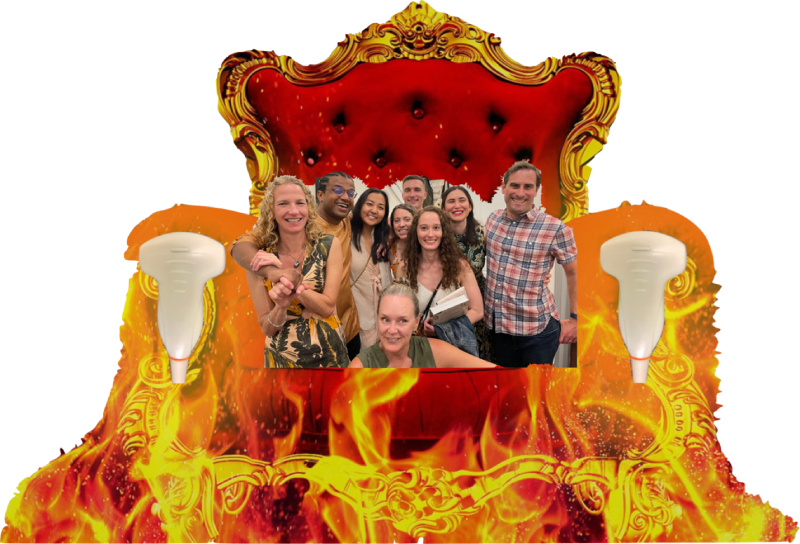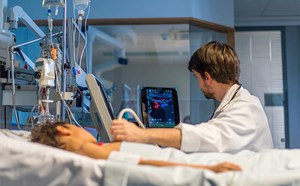
Sono Hot Seat with Nova Panebianco on Multi-Disciplinary Clinical Ultrasound Fellowships
Nova Panebianco, MD, MPH, FACEP
University of Pennsylvania
@Pennultrasound
Questions posed by Stephen Alerhand MD
What ideas or events inspired your team to create an ultrasound fellowship for Multi-Specialty physicians?
Our first Clinical Ultrasound (CUS) Fellow was Dr. Cameron Baston in 2016. At the time, with over 120 EM ultrasound fellowships nationally, and lots of fantastic programs geographically close, filling the fellowship was increasingly stressful. Meanwhile we had more requests than we could handle from specialties outside of EM looking for training. Dr. Baston was already enrolled as a pulmonary critical care medicine fellowship at UPenn and had the support of his leadership to modify his schedule and pilot an innovative multi-specialty ultrasound fellowship training. He had a background in engineering, extensive experience in POCUS research, and didn’t need salary support because of a NIH T32 training grant in cardiopulmonary epidemiology, so it was a perfect opportunity to trial the training program with the plan to codify a financially sustainable option in the future.
When we first conceptualized the collaboration, I underestimated the degree to which the CUS fellowship would be a two-way street. I am rejuvenated each day by our fellows who are from diverse backgrounds [currently 2 EM (one is in her second year and completing a master’s in education), 2 family medicine, and 1 internal medicine fellow] by their capacity to learn, the ideas that they bring, their resiliency as pioneers, and as ambassadors of patient care through innovative technology.
What have been some early successes of this integration and collaboration? Early lessons learned?
Fortunately, at UPenn I didn’t need to convince the Chairs and administrators of “why?” fellowship training is needed, which allowed me to focus on the “how?” I started with my hard requests, taken from our EM US fellowship requirements and the training guidelines, including that the fellows must have Mondays protected for didactics and work a 0.5 clinical FTE or less.
The easiest negotiation was through the ED observation unit that had previously employed non-EM physicians, and was controlled and contracted through the ED. The financial model for our EM ultrasound fellows was almost identical for that of the multi-specialty fellows. Unfortunately, the fact that we couldn’t guarantee a CUS fellow yearly, and the natural yearly turn-over rate, wasn’t a long-term solution. Similarly, observation medicine may be less appealing to a new IM/FM graduate because it may not be reflective of their future clinical environment and can be less fertile a ground for learning CUS while on shift depending on the patient mix.
Sunsetting the observation unit position nudged us to formalize contracted roles with hospitalist medicine and family medicine. The negotiations for these positions were inherently more challenging from having to develop relationships with Division Heads, Chairs, CFOs, and other stakeholders to more challenging issues regarding salary, funds flow, clinical locations, and converting total clinical hours (eg, ED shifts) to work hour units (where nights and weekends are weighted more than daytime units).
I’m certain that had our first few fellows not been such collaborative people, excellent communicators, passionate learners, and pioneers in spirit, this program wouldn’t have been as successful as it’s been. Each fellow took on challenges as an opportunity to improve the program and, retrospectively, they often describe a feeling of being part of something that was bigger than them. In EM we have >20 years of fellowship training experience and pathways for career development, where our CUS fellows at graduation would join a community with fewer than 100 similarly trained individuals in the country.
What were the obstacles to creating this position with administration and/or logistics? How did you address these obstacles?
When working with the administration it was important that the fellowship be cost neutral, or as close to neutral as possible if not profitable. As each fellow was required to not work more than a 0.5FTE it made sense to either start with 2 CUS fellows or align them with other scholarly fellowships in that department if available. EM physicians have higher starting salaries than hospitalist medicine/FM, and the margins that have been used to justify EM ultrasound fellowships did not exist for the other specialties. Solutions for this included having the fellows work a 0.5FTE but receive a PGY4 resident salary. The delta between revenue and salary was returned to the Department of Emergency Medicine, specifically to the Division of Emergency Ultrasound. These funds have been used to support an ultrasound research coordinator, statistician time, fund fellow research projects, support fellows at ultrasound conferences, and create the role of an Associate Fellowship Director.
A somewhat surprising obstacle has been recruitment. Finding internal fellows to start is strongly recommended. We worked with our webmaster to improve our google keyword search function and enhanced the institutional content about the fellowship across the supporting specialties. Knowing how to reach PGY2s outside of one’s specialty is challenging, and social media was very helpful. Word of mouth remains one of the best means of recruitment.
The last obstacle I’d like to discuss is mentorship. The career guidance and needs of an CUS fellow will be different from those of an EM fellow. I strongly encourage developing the role of a CUS Fellowship Director, that would work collaboratively with the EM Ultrasound Director, to provide specialty specific mentorship, training, and aid in recruitment. Funding for that position should come from the collaborating specialty, though creative opportunities through grants, industry sponsorship, or the medical school may be considered.
Since non-EM physicians are not able to work clinically in the Emergency Department, how are these fellowship positions being funded (if you are able to say)?
I spoke about funding above, but a challenge I didn’t fully recognize in the beginning is that the CUS fellows are not credentialled to work in the ED, so they cannot formally staff ultrasound exams the way our EM fellows do. At our institution, CUS fellow exams must be overread and finalized by an EM physician to be billed.
Another challenge to consider is whether the CUS fellow can bill for studies when working clinically in their home department. If this were an ACGME accredited fellowship the answer would be a clear no. However, the CUS fellowship is not ACGME accredited and the fellows are hired as instructors. If a fellow can independently bill for a POCUS exam while in training will likely be decided at the institution-by-institution, department-by-department level.
Fellows from certain specialties (eg, Family Medicine) may be interested in learning, teaching, and researching POCUS applications specific to their field that are not as common in the ED or as exciting to emergency physicians. How do you reconcile this in terms of the time and curriculum you devote to them and whether they have to be engaged separately from your EM-trained fellows?
This has been one of my favorite things about the multispecialty fellowship. I’m now constantly learning new things and pushing my skill set. Let’s be honest, thyroid ultrasound did not thrill me before starting the CUS fellowship, but now I need to know it. Joking aside, curriculum development is a challenge, and when the fellows start in July they may have widely varying skill sets. We have closed July to all rotators and have the fellows do a month-long “boot camp.” They are expected to do 16 hours of scanning shifts per week, the fellowship director comes in and scans with the fellows directly, and we leverage on-line training models, textbooks, didactics, and FOAM content to establish a foundation in core exams.
We are lucky at Penn to have a robust system-wide committee and often use that network to augment the training of our fellows, through grand rounds, scanning opportunities, and mentorship. Over the years we’ve had fellows from critical care, nephrology, hospitalist medicine, family medicine, geriatrics, and med-peds, each with their own learning goals. Once the fellow has a firm grasp on the core aspects of POCUS we encourage exploration out into topics they feel will be valuable in their future clinical environment and to use the network we have fostered.
Do you have a general recruiting pitch to non-EM-trained fellowship applicants? What value is there to them in pursuing fellowship? What opportunities and career prospects does this open?
To be fair, I lose sleep about this all the time. I worry that we have asked these highly intelligent, motivated clinicians to spend a year of training with us, only to be ahead of their time and not find a job that incorporates POCUS or does incorporate it but without any support. Fortunately, with hand-helds and modern technology influencing patient care, our fellows are well poised to be on the top of the tsunami of need for POCUS educators and administrators. So far our CUS fellows have been very successful at finding supported POCUS roles or used their POCUS training to enhance their application for coveted fellowships.
Last gems?
We have changed the conferences we support each year from purely EM to conferences ones that are more multi-specialty friendly. SCUF, WINFOCUS, and the AIUM annual meetings have been crowd pleasers. If you plan to take on multispecialty fellows, I would strongly encourage you to be mindful of conference content and what would have the most yield for the most number of learners.
I cannot say enough about having a Sono Educator in your division. We have Christy Moore, a RDMS certified sonographer who is critical to our division. She comes in every day and scans with the medical students, residents, and fellows, providing support that is impossible to give when working clinically. She has a skill set in vascular, thyroid, female/male GU that augments our EM POCUS skill sets. Having someone who is patient, can teach to every level, is a meticulous imager but understands the nature of POCUS, and can be a resource to your learners is enormously valuable.
Thank you so much for having me on this session!



